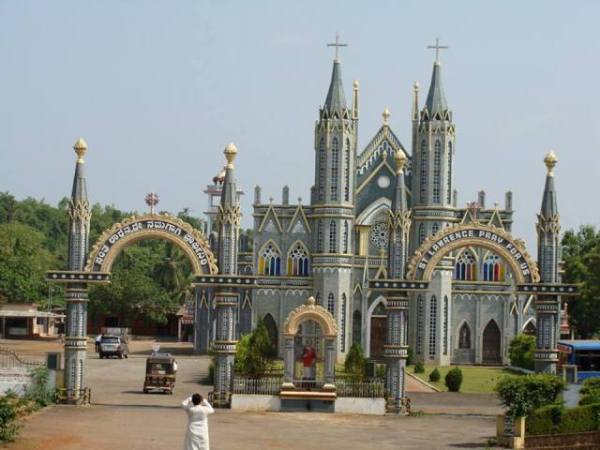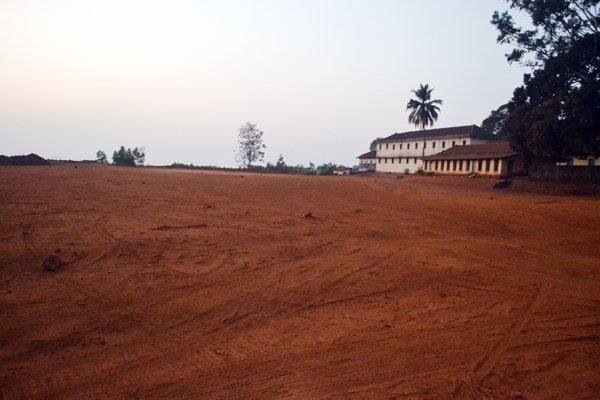The Cross at top of Parpale Hill is said to be erected around 1930-35, on top of the Parpale Hill belonging to St. Lawrence Church Attur. There is a road leading to this Cross and people can climb the distance of 1 k.m. behind the convent. The disabled can go on their vehicles.
On Palm Sunday after the Holy Mass and other usual Palm Sunday ceremony, sizable numbers of people take procession to the top of this hill to the western side of the church where the way of the Cross is conducted every year. There was a decree given by Most Rev. Bishop V.R. Fernandes dated 5.3.1934 by which the devotee praying before the Cross, one Our Father, one Hail Mary and one Glory be is granted 50 days indulgence.

The panoramic view from the top of this hill is simply enchanting. By being an imposing very high place of the locality, the hillocks, trees and greenery from the Arabian Sea to the Western Ghats is spectacular. The silent atmosphere, cool breeze with the background sonorous singing by the birds and the insects are conducive to prayer and meditations.

Karkala-Expansion-work-of-Attur-St-Lawrence-Shrine-on-full-swing
The Parpale Cross hill with a spacious level ground on the top offers itself to have and experience of the Sermon on the Mount if this place is patronized and developed for prayer work ship and spiritual experience.
In the Bible and Indian tradition we see importance given to high places. Noe’s sacrifice on Mt. Ararat, Moses and Mt. Sinai, Jesus going to the mountains to pray are some of the examples fur us to have shrines and places of worship on high places. There are a number of places in our diocese where high places are chosen as cross hills and shrines) The Parpale Cross hill with a spacious level ground on the top offers itself to have and experience of the sermon on the mount if this place is patronized and developed further for prayer work ship and spiritual experience.
The road leading to this Cross Hill is repaired and maintained on regular basis so that people can climb this steep hills distance of 1 k.m. from the side of convent (opp. St Lawrence Pry. School) within 25 minutes and come down within 20 minutes. The disabled or aged people can go on their vehicles till top of the hill.
My Memoirs of Parpale Gudde (Hill) Cross:
– by Prof Dr. John A. Karkala, now in USA
In about 1930-34 Rev. Fr. Salvador D’Souza, Vicar of St. Lawrence Church, Attur, saw that the Parpale Gudde could be a good place to build a cross to be a significant sign on the western skyline of Karkala Town. Rev Fr Salvador D’Souza was a visionary who saw many signs of Christianity flourishing in the region in the forms of chapels, churches, schools, and even a solitary Cross on the top of a hill, a kind of a mini Golgotha in Parasuram Shrasti.
When the Cross was built on top of Parpale Hill and was ready, Most Rev. Bishop V. R. Fernandes, the Bishop of Mangalore, came to bless the Public Cross, and inaugurate Minster service there, a Mass, and the Way of the Cross later on. The ceremony was elaborate for the expected congregation of the parishioners and non-Christians, attending the service.
Jamma (James) D’Silva, son of Francis D’ Silva residing near the Church, was the “miron” (sacristan) who usually served during the Mass by singing in Latin Kyrie eleison, Gloria, Credo, Sanctus, and Angues dei, etc. Though people did not know Latin, they could sing the prayers and participate in Latin Mass, because the words were transliterated into Kannada Script. Anthony Apons, the Masteram, who was Headmaster at St. Lawrence Church School, also joined Jamma miron in singing the ritual answers in latin at the Mass. As an Altar Boy, I was drawn into that process of responding without knowing what the words meant, until later, I found out the translation of the words.
The previous Sunday before the day appointed for blessing the Parpale Gudde Cross, Jamma miron told me that I would be one of the Altar Boys at the Service and that I should take a lobe (set of costume worn by Alter Boys during church ceremony) home and come dressed to the station of the Cross on the hill. So on the day of the ceremony, my father, my younger brother Mark and I got ready in time in the morning. I was wearing the Altar Boy Costume. We started climbing Parpale Gudde from the south side, a steeper side and reached to the top. Then we had to go northwards toward the Station of the Cross. People were already gathering there in crowds. It was a spectacle to watch people dressed in varied colored saris and jackets climbing up as a religious ceremony or as a ritual, with whatever intentions they might have of repenting their sins as one would climb the slopes of Purgatory.
Soon people started gathering round the Cross, and settling down on the ground, and some perching on the stones. Three other Altar Boys dressed in costume had also come, two for the altar service, and two for holding holy water and incense, and swinging the incense burner for blessing the altar and the Cross.
Presently arrived Rev. Fr. Salvador D’Souza in his royal bullock cart. He got down at the foot of steep rise. He was carried up the steep rise by strong men. Then came Bishop’s car and parked at the foot of the steep rise. After the priests and the Bishop were costumed for the ceremony, the Cross was blessed with holy water and incense and appropriate prayers. Then the formal Mass was celebrated in Latin on the western side of the Cross where there was a platform projecting from the base of the Cross to serve as the altar for the Mass. Parishioners prayed in their own language, Konkani; I guess others who witnessed the service made their own meditations in their own languages in the manner of their traditions to join in the spiritual moment of ecumenism. At the end of the Service, the Bishop’s car drove off with Fr. Salvador D’Souza accompanying the Bishop. Many of the things brought from St. Lawrence Church for the purpose of Mass and Blessing the Cross were collected, including Altar Boy’s costumes, and loaded in Fr. Salvador D’Souza’s majestic bullock cart to be taken back to the Church.
With heightened enthusiasm and enlightened feeling people started descending the hill in different directions, some to Karkala town, and some to their homes in different valleys. The mid-day hot sun showered its bright sunshine with equal zest on the ancient Gummatraya in the east, and the newly erected Parpale Gudde Cross on the west, the two spiritual guardians for the people, one echoing “Ahimsa paramo dharma” and the other revealing “Love your neighbor as yourself, and show the other cheek.”
When we started walking towards home, we turned back now and then, to see the Cross Standing high, touching the horizon, and perhaps standing there for a long time to come. Our way forward was downhill.. The valley looked lovely and lusciously green where life in all forms was bristling in the normal way. While signs of civilizations rise and fall, Nature seemed to prevail cyclically, and the grass ever growing greener under our feet seasonally. As we walked father away in space and time, what remained in the memory lane are the two radiating Icons in the interior landscape of our being.
Miraculous Cure due to the veneration of the Cross at the Parpale Hill:
My mother Mrs. Mary Mascarenhas aged 86 years fell down and broke her hipbone on 18th March 2002 and an X-Ray was taken and it showed multiple fractures causing acute pain. The whole leg was swollen. The three doctors who examined her declared that hers was a hopeless case and she cannot be treated due to her age. We took her back home with a plaster on her leg. The pain was unbearable. She was lying on the bed in her agony.
On 24th March 2002, on Palm Sunday there was veneration and Way of the Cross at Parpale hill. I left my suffering mother at home with a neighbour attending on her and our whole family went to the service at Parpale hill at 4.30 p.m. During the service I prayed to the Holy Cross and the wounded Redeemer that my mother may be healed.
To our surprise when we returned home my mother was sitting on the bed declaring that all the pain has disappeared. We observed that all the swelling in her leg is gone and she is cheerful. She wanted her plaster be removed and to walk. I believe this is a miracle by the Crucified Lord venerated at the Parpale hill. Later the doctors were called and they examined her and declared that the healing cannot be explained by natural means.
- Mrs Benedicta D’Mello, Nitte